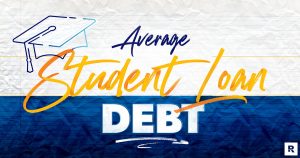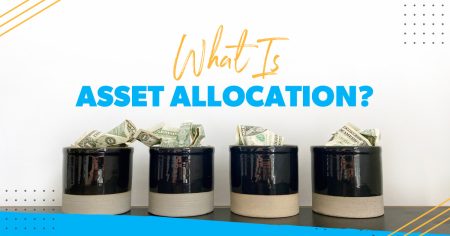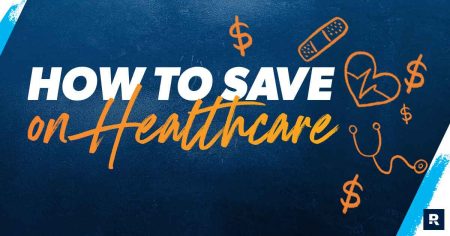Keep reading for the latest nitty-gritty student loan research, including:
Average Student Loan Debt Statistics
Federal Student Loan Debt Statistics
Private Student Loan Debt Statistics
Student Loan Forgiveness Statistics
Student Loan Debt Over Time
Negative Effects of Student Loan Debt
Average Student Loan Debt Statistics
Student loans are the second-largest debt in America behind mortgages.1 And as the cost of college continues to increase, so does the amount of money students are borrowing to get their degrees. It’s a full-blown crisis!
Here are some of the main average student loan debt stats as of January 2025:
- The total student loan debt in America is $1.77 trillion.2
- The average student loan debt per borrower is $38,883.3
- The average student loan interest rate is 6.53% (for federal undergraduate Direct Loans for the 2024–25 school year).4
- 50% of those who receive a bachelor’s degree from a public or private four-year institution graduate with student loans.5
- The average student debt among college graduates is $29,300.6
- Student loan debt increased 2.8% from 2023 Q4 to 2024 Q4.7
- 30% of adults say they took out student loans for their education.8
Federal Student Loan Debt Statistics
There are two kinds of student loans: federal and private. As of January 2025, 42.7 million borrowers have federal student loans—meaning their loans are funded by the U.S. Department of Education.9 In fact, 92.4% of student loans are federal.10
- The total amount of federal student loan debt in the United States is $1.61 trillion.11
- The average federal student loan balance per borrower is approximately $38,883.12
- Those who took out student loans for their child or grandchild’s education have a median amount of $15,000–$19,999 of debt.13
Federal Student Loan Debt by Loan Type
There are three main federal student loan programs: Direct Loans, Federal Family Education Loans (FFEL), and Perkins Loans. Most federal student loan borrowers (38.2 million) have Direct Loans, but borrowers may have more than one type of student loan.14
|
Loan Type |
Total Loan Balance |
Number of Borrowers |
|
Direct Loans |
$1.5 trillion |
38.2 million |
|
FFEL Program Loans |
$165.4 billion |
7.3 million |
|
Perkins Loans |
$3.2 billion |
1 million |
The FFEL Program was the first federal student loan program created in 1965. Though this program was eliminated in 2010 (meaning no new loans have been given out since then), borrowers still owe a combined total of $165.4 billion in outstanding FFEL Program debt.
All new federal student loans are from the Direct Loan Program. And there are three kinds of Direct Loans: Direct Subsidized Loans (bases financial need off the FAFSA), Direct Unsubsidized Loans (doesn’t require proof of financial need), and Direct PLUS Loans (taken out by the student or parent to fill in cost gaps after exhausting private loans).
If a parent takes out a Direct PLUS Loan, it’s called a Parent PLUS Loan. And if a graduate or professional student takes out a Direct PLUS Loan, it’s called a Grad PLUS Loan. The U.S. Department of Education also allows borrowers to combine (or consolidate) multiple federal student loans into one single loan through a Direct Consolidation Loan.
|
Loan Type |
Total Loan Balance |
Number of Borrowers |
|
Direct Subsidized Loans |
$294.4 billion |
30.2 million |
|
Direct Unsubsidized Loans |
$601.5 billion |
30.9 million |
|
Parent PLUS Loans |
$110.3 billion |
3.6 million |
|
Grad PLUS Loans |
$112.1 billion |
1.8 million |
|
Direct Consolidation Loans |
$517.2 billion |
9.5 million15 |
Of the $99 billion in student loans that were given out for the 2023–24 school year:
- 44% were federal unsubsidized loans
- 16% were federal subsidized loans
- 14% were Grad PLUS Loans
- 13% were nonfederal loans
- 12% were Parent PLUS Loans16
Federal Student Loan Interest Rates
Interest rates for federal loans change over time and vary based on loan type and disbursement date (aka the date when funds are given to the borrower). Perkins Loans are the only exception—those have a fixed rate of 5%.
The average student loan interest rate is 6.53% (for undergraduate Direct Loans given out between July 1, 2024, and June 30, 2025).17
|
Loan Type |
Borrower Type |
Fixed Interest Rate |
|
Direct Subsidized and Direct Unsubsidized Loans |
Undergraduate |
6.53% |
|
Direct Unsubsidized Loans |
Graduate or Professional |
8.08% |
|
Direct PLUS Loans |
Parents and Graduate or Professional Students |
9.08% |
Federal Student Loan Debt by Amount
Roughly 23% of borrowers have between $20,000–40,000 in federal student loans, followed by 21% of borrowers with $10,000–20,000 in federal student loans, and 17% of borrowers with $5,000–10,000 in federal student loans.18
About 17% of borrowers have less than $5,000 in federal student loans. And 3.6 million borrowers (8.4%) have more than $100,000 in federal student loans.
|
Loan Balance |
Number of Borrowers |
|
Less than $5,000 |
7.2 million |
|
$5,000–10,000 |
7.4 million |
|
$10,000–20,000 |
9.1 million |
|
$20,000–40,000 |
9.7 million |
|
$40,000–60,000 |
4.2 million |
|
$60,000–80,000 |
2.5 million |
|
$80,000–100,000 |
1.4 million |
|
$100,000–200,000 |
2.5 million |
|
$200,000 or more |
1.1 million |
Average Student Loan Debt by Age
Borrowers ages 35–49 have the largest amount of student loan debt with a total of $646.6 billion. The 25–34 age group is the second highest with $487.3 billion worth of student loan debt.19
Even the older generations (age 62 and older) collectively owe around $121.5 billion of federal student loans. But it’s not clear whether this total is from a degree earned later in life, lingering loans from their youth, or money they borrowed to put their children or grandchildren through school.
|
Age |
Total Loan Balance |
Number of Borrowers |
|
24 and Younger |
$96.3 billion |
6.8 million |
|
25–34 |
$487.3 billion |
14.7 million |
|
35–49 |
$646.6 billion |
14.6 million |
|
50–61 |
$290.1 billion |
6.2 million |
|
62 and Older |
$121.5 billion |
2.8 million |
Average Student Loan Debt by Race
Black borrowers are more likely to carry higher student loan balances than White or Hispanic borrowers. In fact, 52% of Black borrowers have at least $25,000 of student loan debt from their own education, compared to 41% of White borrowers and 37% of Hispanic borrowers.20
Hispanic borrowers are more likely to be behind on their student loan payments than White, Black or Asian borrowers.21
Average Student Loan Debt by State
Washington, D.C., has the highest average student loan debt of any state with $54,468 per borrower. Residents in Maryland, Georgia, Virginia and Florida also have higher student loan balances than other states.22
|
State |
Average Loan Balance |
|
Washington, D.C. |
$54,468 |
|
Maryland |
$43,895 |
|
Georgia |
$42,148 |
|
Virginia |
$40,313 |
|
Florida |
$39,534 |
|
Delaware |
$39,114 |
|
Illinois |
$39,054 |
|
Hawaii |
$38,898 |
|
New York |
$38,884 |
|
North Carolina |
$38,834 |
Federal Student Loan Status Statistics
From March 2020 until October 2023, federal student loan payments were on pause due to student loan debt relief. But many borrowers didn’t start making payments until after the 12-month ramp up period ended in October 2024—even though interest was still accruing during that time.
In fact, 16% of student loan borrowers reported being either behind on their payments or in collections for at least one of their student loans in October 2023.23
As of 2024 Q4, almost half (45.7%) of student loan borrowers are in active repayment. Around 21% of borrowers are currently in student loan forbearance, and 13% of borrowers are in default with their student loans.24
|
Loan Status |
Total Loan Balance |
Number of Borrowers |
Percentage of Total Borrowers |
|
In-School |
$110.2 billion |
6.1 million |
14.3% |
|
Grace Period |
$38.4 billion |
1.6 million |
3.8% |
|
Active Repayment |
$630 billion |
19.5 million |
45.7% |
|
Deferment |
$132.4 billion |
3.3 million |
7.7% |
|
Forbearance |
$507.9 billion |
9 million |
21.1% |
|
Default |
$123.7 billion |
5.6 million |
13% |
|
Other |
$6.5 billion |
0.1 million |
.23% |
- In-School: loan payments haven’t begun because the student is still in school
- Grace Period: payments haven’t begun because the borrower doesn’t have to start paying until six months after graduation (does not apply to PLUS loans)
- Active Repayment: payments are being made, and the borrower’s account is active
- Deferment: in deferment, payments are postponed because of financial hardship, military service or returning to school; interest may or may not grow
- Forbearance: payments are on pause, but interest continues to grow
- Default: loans are more than 360 days delinquent
- Other: loans are currently in bankruptcy or disability status
Federal Student Loan Repayment Plan Statistics
The average student loan payment is over $200.25 But each borrower’s monthly student loan payment depends on their individual loan balance, interest rate and repayment plan.
Most student loan borrowers (14.19 million) are on the standard 10-year fixed repayment plan.26 But it can take longer to pay off your student loans. In fact, 40% of college students who graduated before 2013 still have student loan debt compared to 76% of those who graduated after 2013.27
About 4 million student loan borrowers are on either an Income-Contingent or Income-Based Repayment plan. Approximately 1.34 million borrowers are on the Pay As You Earn (PAYE) Repayment plan. And about 8 million student loan borrowers are currently enrolled in the Saving on a Valuable Education (SAVE) plan.28
|
Repayment Plan |
Total Loan Balance |
Number of Borrowers |
|
Level, 10 Years or Less |
$302.5 billion |
14.19 million |
|
Level, More Than 10 Years |
$89.8 billion |
1.8 million |
|
Graduated, 10 Years or Less |
$66.5 billion |
2.45 million |
|
Graduated, More Than 10 Years |
$35.5 billion |
0.65 million |
|
Income-Contingent |
$51.3 billion |
1.24 million |
|
Income-Based |
$132.7 billion |
2.76 million |
|
Pay As You Earn |
$101.6 billion |
1.34 million |
|
SAVE |
$449.6 billion |
8 million |
|
Alternative |
$25.3 billion |
0.78 million |
- Level, 10 Years or Less: standard repayment plan with fixed payments over a period of 10 years or less
- Level, More Than 10 Years: fixed payments over a period of more than 10 years
- Graduated, 10 Years or Less: payments gradually increase over a period of 10 years or less
- Graduated, More Than 10 Years: payments gradually increase over a period of more than 10 years
- Income-Contingent: payments calculated based on borrower’s adjusted gross income, family size and total loan amount
- Income-Based: payments capped at 10% or 15% of borrower’s discretionary income, depending on when they borrowed
- Pay As You Earn: payments capped at 10% of borrower’s discretionary income
- SAVE: available for Direct Loans only; payments based on a percentage of borrower’s income (replaced REPAYE)
- Alternative: repayment plan customized to the borrower’s specific circumstances
Private Student Loan Debt Statistics
Private student loans (aka nonfederal loans) come from a bank, credit union, state loan agency or some other kind of financial institution.
Private student loans make up about 7.6% of the total student loan debt in the U.S.29 But private student loans usually charge higher interest, and borrowers don’t have the same rights as they do with federal loans.
- The total private student loan debt in the United States is approximately $134.19 billion.30
- Private student loan interest rates can range between 4% and 16%.
- About 93.5% of private student loans for the 2024–25 school year had a cosigner.31
Student Loan Forgiveness Statistics
A lot has happened with student loan forgiveness over the past five years. From March 2021 through December 2024, over $183 billion of student loan debt was forgiven.32 But many forgiveness efforts (including President Biden’s student loan debt relief plan) have been shot down by U.S. federal courts.
- Only 1.2% of the 4.5 million Public Service Loan Forgiveness (PSLF) applications that were submitted between November 2020 and January 2023 met the requirements for forgiveness.33
- Only 469,600 borrowers have had their student loans forgiven under Teacher Loan Forgiveness (TLF) since the program started in 2009.34
- A total of $3.89 billion in student loan debt has been discharged under Borrower Defense to Repayment (when a school violates certain laws or misleads students into taking out loans to go to college).35
Student Loan Debt Over Time
Student loan debt in America has risen more than 361% since 2004.36 This is mostly due to the increasing cost of tuition. In fact, from the 2004–05 school year to the 2024–25 school year, average tuition and fees increased:
- 17.05% for a public two-year school
- 36.11% for a public four-year school
- 30.02% for a private nonprofit four-year school37
And more expensive tuition and a rising cost of living leads to . . . (you guessed it) more student loan debt. Students are more tempted than ever to take out loans for their education, without weighing the real cost.
Negative Effects of Student Loan Debt
Not all student loan borrowers graduate or use their degree.
With the cost of college rising and student loan debt at an all-time high, is it even worth it to take out student loans for an education?
Well, 22% of borrowers who graduated during the 2015–16 academic year had trouble making payments on their student loans during their first year out of college. And only 40% of those college graduates landed a salaried job within their first year after graduating, and 44% of graduates took a job outside their field of study.38
It’s not clear if having student loans caused this, but the pressure of making payments certainly doesn’t help graduates pursue a job they’re passionate about.
And here’s the real kicker: About 45% of high school grads will go on to attend a four-year college, but only about 64% of those students will actually graduate from college.39,40 And the students who took out student loans but didn’t complete their degree still have to pay back their loans—plus interest. Oof.
Student loan debt can hold borrowers back financially and personally.
Even if you graduate from college and get a job using your degree, student loan debt can keep you from making progress financially. In fact, one study found that student loan payments have a “statistically significant negative impact” on how much employees are able to contribute to their company 401(k).41
It comes down to a lack of knowledge around student loans. According to Ramsey Solutions’ State of Personal Finance study:
- Almost one-third of Americans (32%) didn’t understand the consequences of taking out student loans before they signed up for them42
- 71% of those who took out student loans to pay for college say they wish they’d been better educated about the debt before taking it on43
- A little over half (51%) of those who took out student loans regret borrowing money to go to college44
- 43% of those who took out student loans regret going to college altogether45
Additionally, 7 in 10 student borrowers have delayed major life events—including moving out of their parents’ home, getting married, and having children.46
As you can see, student loan debt affects more than just people’s finances—it also impacts their life decisions. And until the federal government stops guaranteeing student loans, this problem is most likely going to keep getting worse.
The good news is, you don’t have to be just another statistic. If you’ve got student loan debt, you can pay it off, without waiting around for a politician to maybe forgive it one day.
The exact student loan debt numbers will continue to change. But one thing remains constant: You have the ability to take charge and proactively pay off your student loans.
Read the full article here










